
How Long Should it Take to Renovate a House?
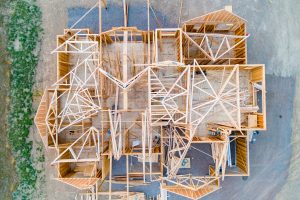
How Long Should It Take to Renovate a House?
Remodeling is a big investment – not just in regards to money and your assets, but also your personal space and time. We get a lot of calls asking about large-scale remodeling projects with quick turnaround times. Common questions include, can you complete a whole-house remodel this summer? Can I start the construction of my kitchen remodel in the next two months? Or will you be able to start and finish a bathroom while my family goes on a week-long vacation next month? So, just how long should it take to renovate a house?
These are great questions. At Red House, our mission is to provide everyone we speak with the most accurate advice and knowledge about the remodeling process, whether or not we end up working together. We created our design-build process to take as much of the guessing part out of the equation as possible when it comes to schedule and costs. Our goal is to shatter the stigma that all contractors always go late and over budget. We also want to be honest and upfront with clients about these factors so you can have a realistic understanding of what to expect.
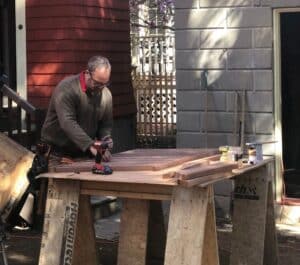
So how long should it take to renovate a house?
There’s no one-size-fits-all answer to this question. A project doesn’t just begin on day one with knocking down a wall. A project begins with planning and design, and this should happen long before anyone ever picks up a tool. Many factors impact the answer to “how long should it take” – the scope of your project, the availability of materials, zoning and permitting, and the type of service you desire. A powder room remodel will obviously take less time than a full-house renovation. Lead times of materials can slow due to world events like the pandemic. Furthermore, a small carpentry practice might give you a quicker turnaround on starting a project with limits to design, prior planning, and sometimes skill, whereas a full-service design-build company will take a time longer to plan, but end up providing you with far more value and a shorter production time-frame.
Over the next few weeks, we are going to go into further detail on each of these subjects – breaking down scheduling and costs for individual projects like kitchens, baths, and additions. We’ll go deeper into which materials are delayed right now and we will explain the difference between design-build, a general contractor, and “Chuck-in-a-truck” construction.

When to Start Planning a Future Project (now)
In the meantime, if you are considering your next home renovation project, you might be asking yourself, “how far in advance should I start planning a remodel with a design-build company like Red House?” Our production schedule is currently booking into 2022. That means, new projects in our queue will begin construction early next year, but the design process will start much earlier.
Having registered in-house architects and designers sets our design-build firm apart from working with a general contractor or an independent carpenter. We provide an in-depth design process that covers layout, design details, ordering materials, and budgeting. Our design team works together with our production team of highly skilled carpenters, so there are no surprises, hidden costs, or lack of transparency.
Without this design service, you need to either hire a separate architect to create your plans and then bid out your project out to an unrelated contractor (who may not be on the same page as your architect), forego personalized design for a simple, cookie-cutter plan, or you may end up responsible for making hundreds or even thousands of decisions and orders for design and material selections yourself (a full-time job). In short, design-build takes that weight off your shoulders, allows certified experts to handle the details for you, so you can continue to live comfortably through your remodel.
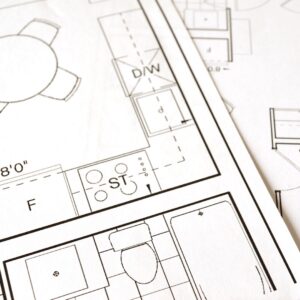
Here is the timeline of a design-build process:
Book a Walk-Through of Your Home
After the initial Discovery Call where you discuss the details of your project, your timeline, and your budget, our office will book a walk-through of your home with one of our Project Developers if we seem to be a good match. The Project Developer will walk your home and get a better understanding of what possibilities exist for your project. If we seem like a good fit, they will present you with a design proposal, outlining the scope and preliminary budget for your project. Once you approve this proposal, you deposit a design and planning fee to hold your spot in our production schedule and enter you into the preconstruction and design process.
Start the Design Process with Design Phase 1: Architectural Layout
Once you sign a design proposal, you will have your first design meeting within 3-8 weeks (depending on the design department’s current workload and size of the project). During Phase 1 of the design process, you work closely with your lead designer to come up with the architectural layout of your project. This process takes (on average) about 8-12 weeks, depending on the size of your project.
At your first design meeting, your Lead Designer presents 2-3 options to choose from for the layout of your space. These options may vary depending on your budget range (for example, an option at the top and the bottom of your range) or may depend on your scope (i.e. whether or not to include certain details that you are on the fence about). Over the course of 3-4 meetings, you will make customizations to your favorite scheme by viewing stunning 3D renderings and informative 2D plans.
The design team will get to know you, your family, as well as your hopes, dreams, and concerns. The result is a space designed with you in mind. We call this “style-specific design”. We design for our client’s vision – we don’t push a certain style. Of course, as trained and experienced professionals, our expert team will guide you through every step on your journey from dream to completed build.
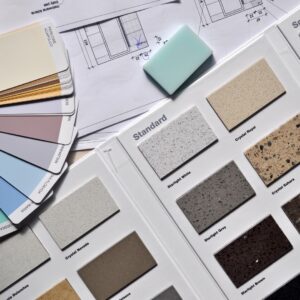
Design Phase 2: Choosing Your Style Details
During Phase 2 of the design process, you will work closely with our Selections Coordinator to choose all of the details of your project – paint colors, cabinet doors, lighting fixtures, flooring – all the fun parts and pieces that make your home styled and complete. This part of the process usually takes about 4-12 weeks, depending on the size of the project and whether selection choice deadlines are met on time by the client.
Because hundreds of selections decisions might be necessary for a large-scale remodeling project, we break this process down into several meetings so you don’t get overwhelmed with too many choices at once. It’s important to complete each selection decision so it aligns with the overall project timeline. This keeps the project on schedule. Delaying a decision can cause a domino effect, causing orders to be put off, and (in the worst case), your spot the production queue being bumped. You will see visual presentations with choices laid out for you at each of your design meetings. Then you can use our handy project management app to make your final decisions while keeping a running tab of your spending allowances. At every meeting, you will see the pieces of your project fit together like a puzzle coming ever nearer to completion.
Ordering, Permits, and Planning
As soon as we can, we will begin ordering the materials for your project based on your selection choices. Material lead times may vary, especially for special orders or during a worldwide event like a pandemic, but we stay abreast of these issues and try whenever possible to take delays into consideration when creating your schedule.
During this Planning Phase, we also secure all the permits and paperwork necessary to undertake the project. Whether or not you work with Red House, it is extremely important that you work with a company that follows all legal requirements for a remodel. This phase typically takes about 4 weeks to complete.
Time to Start Construction!
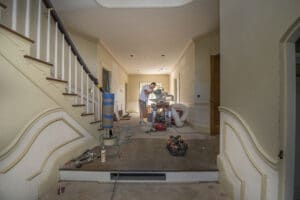
It’s time to hand the project off to our production team. Your build will be managed by a Lead Carpenter – a highly skilled craftsperson and project manager. At this point in the process, from when you signed the contract to now, it has already been about 19-36 weeks, depending on the size and complexity of your project. With this in mind, starting construction in early 2022 doesn’t seem as far away.
All of those months of prep mean that when construction begins, everything has been planned, budgeted, ordered, and accounted for – limiting surprise changes and costs as much as possible. Obviously, there can sometimes be hidden issues that arise that can’t be detected until demolition – things like rot, mold, or extensive internal damage that needs to be addressed. Sometimes these situations are unavoidable, but the key is to prepare as best you can for everything else so that any unforeseen surprises can be quickly handled.
Construction times will vary from project to project based on existing conditions and scope. All the planning completed during the design phases streamlines the overall length of the production process, keeping everyone involved aligned with the final plan and timeline. We will cover individual project types with real-world timeline examples in upcoming articles, so stay tuned.

Are You a Candidate for Design-Build?
Not everyone is looking for a full-service approach to their remodeling project, and we respect that. If that is the case, we will do everything we can to answer any questions you may have or refer you to a reputable company that might be a better fit. But one thing is guaranteed, when you want to make a major change to your home with a considerable cost, it is vitally important that you trust the company handling it.
Our process offers clear communication through visual presentations, frequent meetings, daily logs on our app with photographs of our progress, and more – so you are never left in the dark. You’ll understand your options, work with highly skilled architects and design professionals, and you’ll have a Lead Carpenter managing your build with upfront knowledge of your project from start to finish. But this process takes time. So start planning your project for 2022 or even 2023 now. Contact us today to get started.
- Category :
- Type :

